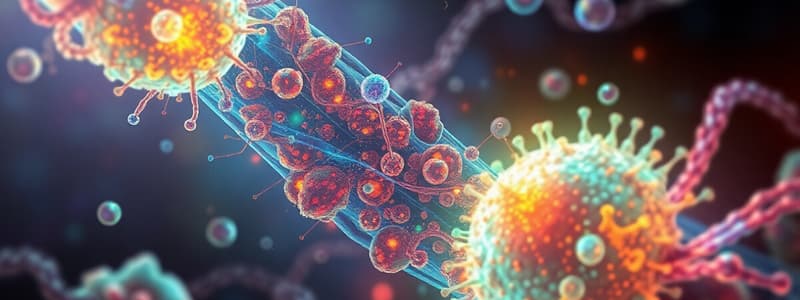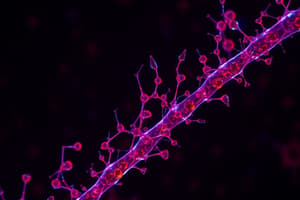Podcast
Questions and Answers
Which of the following domains of life are considered prokaryotic?
Which of the following domains of life are considered prokaryotic?
- Eukarya
- Archaea
- Both B and C (correct)
- Bacteria
What are isotopes defined by?
What are isotopes defined by?
- Different number of neutrons (correct)
- Different number of electrons
- Different number of protons
- Same number of neutrons
Which of the following is NOT one of the three foundations of cell theory?
Which of the following is NOT one of the three foundations of cell theory?
- All living organisms are made up of cells
- Cells can arise from non-living substances (correct)
- The cell is the basic unit of structure and function
- All cells come from pre-existing cells
Which of the following reactions is NOT part of mRNA processing in eukaryotes?
Which of the following reactions is NOT part of mRNA processing in eukaryotes?
What is the primary function of the rough endoplasmic reticulum?
What is the primary function of the rough endoplasmic reticulum?
Which of the following statements about the domains of life is true?
Which of the following statements about the domains of life is true?
What distinguishes prokaryotes from eukaryotes based on their cellular structure?
What distinguishes prokaryotes from eukaryotes based on their cellular structure?
Which of the following correctly describes isotopes?
Which of the following correctly describes isotopes?
What is a key component of cell theory regarding cell origin?
What is a key component of cell theory regarding cell origin?
Flashcards
Domains of Life
Domains of Life
The three major groups of organisms: Bacteria, Archaea, and Eukarya.
Prokaryotic/Eukaryotic Cells
Prokaryotic/Eukaryotic Cells
Cells without a nucleus (prokaryotic) or with a nucleus (eukaryotic).
Cell Theory Foundations
Cell Theory Foundations
All living things are made of cells, cells are the basic unit of function, and cells come from pre-existing cells.
mRNA Processing Reactions
mRNA Processing Reactions
Signup and view all the flashcards
Rough Endoplasmic Reticulum Function
Rough Endoplasmic Reticulum Function
Signup and view all the flashcards
What are isotopes?
What are isotopes?
Signup and view all the flashcards
Prokaryotic Transcription Location
Prokaryotic Transcription Location
Signup and view all the flashcards
Eukaryotic Gene Arrangement
Eukaryotic Gene Arrangement
Signup and view all the flashcards
Lysosomes Function
Lysosomes Function
Signup and view all the flashcards
Rough ER Evolution
Rough ER Evolution
Signup and view all the flashcards
Study Notes
Biology 1050 Final Exam (2023FA) - Multiple Choice Questions
- Protein primary structure is the amino acid sequence.
- All tRNA molecules have the same sequence at their 3' end for amino acid attachment.
- Signal recognition particle (SRP) directs proteins to the rough endoplasmic reticulum.
- Structurally and functionally related proteins form families.
- Eukaryotic translation begins with recognition of the 5' cap and scans for the first AUG triplet.
- Protein phosphorylation is a post-translational modification.
- Protein families align with folding domains.
- The tRNA that binds the start codon has the sequence 5'-UAC-3' at its amino acid attachment site.
Biology 1050 Final Exam (2023FA) - Multiple Choice Questions
- Insulin is a secreted protein.
- A compound that inhibits SRP recognition would lead to insulin accumulation in the cytosol.
- A key aspartic acid in Protein X likely needs to be substituted with a hydrophilic amino acid for proper protein folding.
- Spider silk strength results from a high proportion of β sheets and small hydrophobic amino acids.
Biology 1050 Final Exam (2023FA) - Multiple Choice Questions
- Glycine increases the flexibility of the peptide backbone.
- The Shine-Dalgarno sequence is recognized by the small subunit of the bacterial ribosome.
- SRP-bound proteins are synthesized on the rough endoplasmic reticulum.
- Insulin is translated and packaged in the rough ER/secretory vesicles.
- Transmembrane proteins need both a signal sequence and a signal-anchor sequence.
- Folding domains demonstrate how structure relates to function.
- Elongation factor interacts directly with stop codons.
Biology 1050 Final Exam (2023FA) - Multiple Choice Questions
- The number of possible polypeptides with 10 amino acids using 20 amino acids is 20¹⁰.
- Translation for proteins destined for the nucleus occurs on ribosomes bound to the outer nuclear membrane.
- Protein-folding domains facilitate transport, catalysis, and protein interactions.
- Correct amino acid attachment to tRNA is ensured by aminoacyl-tRNA synthetases.
- The 3' position of a codon can have some variations without affecting the amino acid.
Biology 1050 Final Exam (2023FA) - Multiple Choice Questions
- A folding domain exhibits a primary structure comprised of phenylalanine residues.
- Most mRNA sequences translate to proteins in three frames.
- Peptide bond formation in catalyzed by RNA.
- Mutation of the nucleotide in the fourth codon will change the anticodon.
- Correct amino acid assignment to tRNA in crucial.
Biology 1050 Final Exam (2023FA) - Multiple Choice Questions
- Polysaccharides are assembled in an anabolic process.
- First law of thermodynamics states that energy cannot be created or destroyed.
- Gibbs free energy represents available energy in a system.
- Enzymes influence the activation energy and products of chemical reactions.
- Organisms that derive both energy and carbon from organic compounds are chemoheterotrophs.
- Stored energy is known as potential energy.
Biology 1050 Final Exam (2023FA) - Multiple Choice Questions
- Allosteric inhibitors bind to an enzyme's non-active site.
- Plant cells use sunlight directly for energy.
- Chemical reactions generate entropy (disorder).
- Entropy increase tends to occur as heat.
- Certain organisms obtain energy and carbon from existing organic compounds (heterotrophs).
- A substance that has a higher chemical potential energy is considered exergonic.
Biology 1050 Final Exam (2023FA) - Multiple Choice Questions
- Carbon-carbon covalent bonds are strong bonds with high potential energy.
- Evolution does not violate the second law of thermodynamics because entropy increase in the environment compensates for decrease in living organisms.
- Spontaneous reactions have a negative ΔG.
- ATP's components are ribose, adenine, and a phosphate chain.
Biology 1050 Final Exam (2023FA) - Multiple Choice Questions
- Molecular compounds like carbohydrates and lipids contain strong covalent bonds with large potential energy.
- Cellular processes require an efficient use of energy during times of high demand.
- The process of cellular respiration consists of multiple metabolic reactions that are important to the overall amount of ATP production.
- Correctly identifying the reactants and products required to correctly categorize metabolism are important.
- Photosynthesis is a major process in plants that helps to provide energy to other organisms.
Biology 1050 Final Exam (2023FA) - Multiple Choice Questions
- The energy source for photosynthesis is water.
- Photosystem II and I are involved in the production of NADPH and ATP.
- The carboxylation phase of the Calvin cycle uses RuBP.
- Xanthophyll pigments have the capability to convert light into heat.
- All eukaryotic cells which have chloroplasts benefit from endosymbiosis in some manner.
- Photosynthesis is an important process associated with the survival of all organisms.
Biology 1050 Final Exam (2023FA) - Multiple Choice Questions
- ATP and NADPH are products of light-dependent reactions.
- Proton transport in the electron transport chain generates a proton gradient for energy.
- The Calvin cycle requires the products of light-dependent reactions for the production of glucose.
- Several factors can cause reactive oxygen species to form.
- ATP synthesis and energy production in cells require specific processes and reactions in various organelles.
Biology 1050 Final Exam (2023FA) - Short Answer Questions
- Domains of life: Bacteria, Archaea, Eukarya.
- Eukarya is eukaryotic, while Bacteria and Archaea are prokaryotic.
- Chemical elements are defined by the number of protons.
- Isotopes are atoms of the same element with different numbers of neutrons..
- Cell theory foundations: cells are the basic unit of life, all living things are made of cells, and cells arise from pre-existing cells.
Biology 1050 Final Exam (2023FA) - Short Answer Questions
- Table comparison of prokaryotes and eukaryotes, based on presence or absence of key features.
- mRNA processing reactions in eukaryotes include: capping, splicing, and polyadenylation.
Biology 1050 Final Exam (2023FA) - Diagram Labeling and Function
- Diagram labeling of animal cell components.
- Function of the cytoskeleton: provides internal structural framework.
Biology 1050 Final Exam (2023FA) - Short Answer Questions
- Three domains of life: Bacteria, Archaea, Eukarya.
- Eukaryotic domains are Eukarya, and prokaryotic are bacteria and archaea.
- Defining element: proton number.
- Isotopes share the same proton number but differ in neutron number..
- Cell theory tenets: cells are fundamental unit, cells arise from pre-existing cells, and all organisms are composed of cells.
Biology 1050 Final Exam (2023FA) - Diagram Labeling and Function
- Label diagram of animal cell.
- Function of component C (Diagram): cytoskeleton.
- Cellular component C likely evolved from: simpler precursors.
Studying That Suits You
Use AI to generate personalized quizzes and flashcards to suit your learning preferences.




